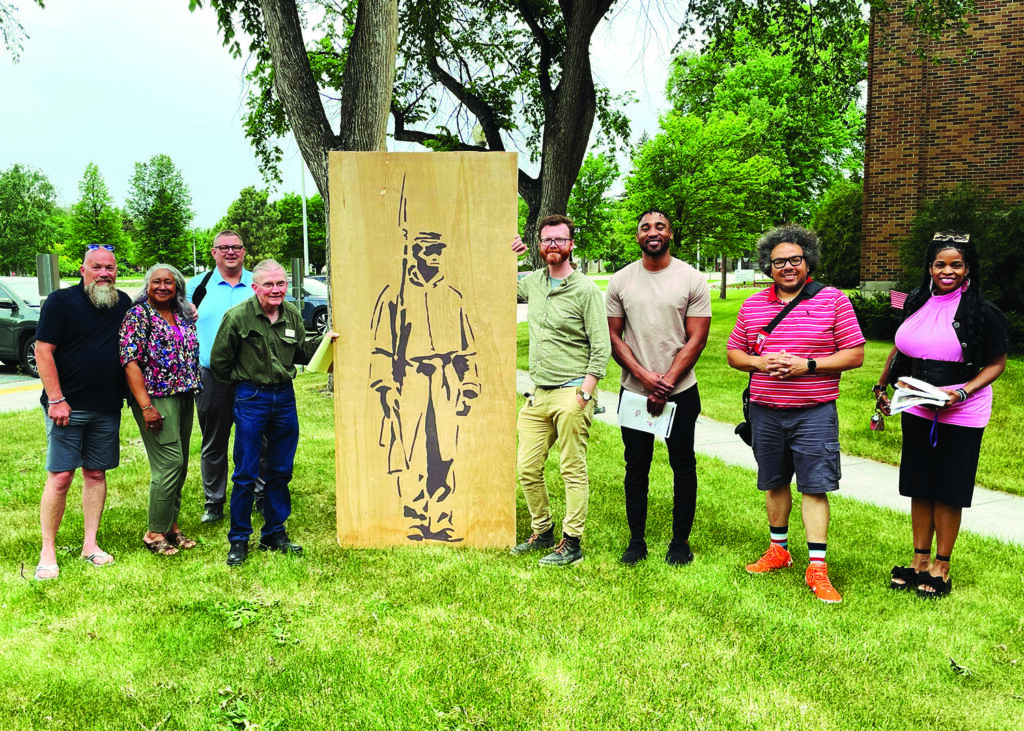
Some members of the Battles advisory committee posed on site in June with a wooden replica. (From left) Rick Dekarske, Gracia Sanchez-Dekarske, Ryan Nelson, Mark Peihl, Felix Battles, Markus Krueger, Delson Saintal, Jered Pigeon and Rachel Stone. (Photo/ HCSCC)
Nancy Edmonds Hanson
A statue dedicated to Moorhead’s pioneer barber, Felix Battles, is being unveiled Saturday on the campus of Minnesota State University Moorhead – 150 years after the Civil War veteran, enslaved in Mississippi as a teen-ager, was drawn here for a job building the Northern Pacific Railway.
The statue will be unveiled at 11 a.m. Saturday on the grounds of MSUM’s Center for Business. It’s just steps away from the spot where Battles, his wife Kate and their extended family once lived. He died in 1907, when his obituary told of “a quiet man respected by all who knew him.”
The statue is a massive incised plank of three-quarters-inch steel, eight feet tall and four feet wide. The thousand-pound monument will stand on a compact concrete plaza, eventually encircled by benches and interpretive markers telling his story.
As its designer, Markus Krueger, explains, it depicts an African American Union soldier, but not specifically Battles. “We haven’t been able to find a photograph of Felix himself,” the Historical and Cultural Society of Clay County program director says. “In a sense, it has also become a tribute to all of the 104 Black Minnesotans who served during the Civil War.”
That’s part of Battles’ saga. He escaped and made his way north to St. Paul, Minnesota. In 1864 he signed up there to fight the Confederates. He rose to the rank of corporal in the segregated 18th U.S. Colored Infantry.
After the war, the 31-year-old veteran became one of the first African Americans to arrive in Moorhead to help build the transcontinental railroad. He soon moved into the career that would define the rest of his life, barbering men’s hair. “Barbering was the number-one opportunity that brought Black families to Moorhead and Fargo,” Krueger reports, a fact uncovered by archivist Mark Peihl’s research. “At least the first five families came here as barbers. They were considered the finest barbers of that time.” Battles operated his barbershop in several locations over some 40 years, including near the former Wells Fargo Bank and, later, near the present Vic’s Lounge, as well as the location of the former Wimmer’s Jewelry on Main Avenue in Fargo.
While historians of the HCSCC had known of Battles, his story – and the idea of a monument – came into focus about 5 years ago. “Statues of Confederate Civil War heroes were in the news, along with the debate over whether they should be taken down,” Krueger remarks. “I thought to myself, ‘Who deserves a statue more than Robert E. Lee is Felix Battles.’ Then I thought, ‘Well, why not?’”
Without a portrait of the barber, he designed the silhouette that would later be incorporated into the new statue. “Originally I thought of making it into a stencil and just painting it somewhere,” he goes on. But then he saw incised metal art by his neighbor Lyle Landstrom, a civil engineer, and the idea took on three dimensions.
Krueger presented a program on Moorhead’s pioneer barber as part of Junkyard Brewing’s monthly “History on Tap” series. “By the time I got on stage, we’d raised the $2,000 we thought we needed for the statue,” he remembers.
An advisory committee he calls the “dream team” began laying plans for the monument, starting with hunting the right spot. They weighed 18 possibilities before settling on the MSUM campus, so close to the Battles homes more than a century before.
That was in June. Since then, Krueger’s design was enlarged and, with the assistance of Landstrom, assigned to Sanders Metal Products for production. There, the steel slab was carved by a computer-driven high-pressure water jet the size of a pencil lead infused with crushed garnet. The soldier’s silhouette matches Battles’ height of 5 feet 8 inches. The additional distance is covered by a bayonet mounted on his rifle.
The cost of the project has risen since the metal panel was carved. While early donations easily covered the cost of the statue itself, the concrete plaza and foundation that will hold it erect have added about $8,000 to the final price, with several thousand dollars still needed to cover those expenses. HCSCC is hoping to secure a grant to underwrite the interpretive panels.
Battles appears to have no living direct descendants, according to Krueger, who searched for relatives during research for the project. The FM community included about 200 Black individuals in the early years of the 20th century, but most moved away in subsequent years.
Perhaps that’s why the barber’s story – and that of his peers – faded over the years. Now, Krueger and Gabby Clavo, the HCSCC communications manager, suggest that the monument to Felix should be understood as a tribute to not only him, but all the African Americans who made Moorhead and Fargo their home early in the area’s history. “The statue is a symbol of that history – a way for people to recognize that they were here,” Clavo says. “It recognizes forgotten heroes, particularly among people of color, who made great sacrifices for our community.
“Felix Battles is a man Moorhead can be proud of,” she observes. “This monument will help keep his legacy alive.”


